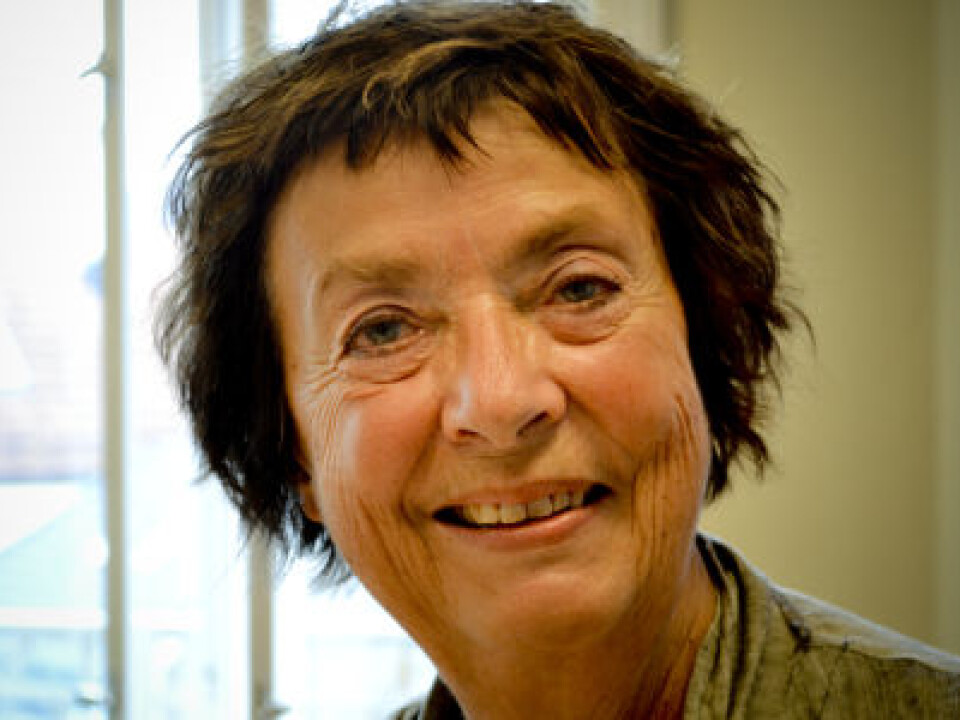An article from KILDEN Information and News About Gender Research in Norway

“Many die from studying science”
When Solveig wanted to switch her major from English to natural science, the professor for the class was so distressed about getting yet another female student that he tried to scare her away. “It’s so difficult. There are many who die,” he said
Denne artikkelen er over ti år gammel og kan inneholde utdatert informasjon.
Solveig is one of a hundred women over 70 years old who were interviewed for the project “Document 100 Women”.
Kari Gaarder Losnedahl, a professor emerita at the University Museum of Bergen, is responsible for the interviews with women in academia. A theatre scholar and researcher in women’s and cultural studies, Losnedahl talked about the interviews during a seminar organized by the Centre for Women’s and Gender Research in Bergen this spring.
“My presentation is not an analysis, but a sampling from 16 different personal stories. All of the women interviewed were born before the war, chose a career in academia, and entered a primarily male society.”
Jenny-Rita tells this story: Being a female curator was unusual in my day. At company parties I was not supposed to dance with the conscientious objector or wear long pants when I was not out in the field. I was also asked to do the dishes, like the other office ladies did. I said that I could certainly do that, if the male curators did the same. In the end, I got out of doing the dishes.
Relevant today

“Norwegian museums are so full of His story. Now the time has come to document and profile Her story.” Losnedahl is quoting Kari Sommerseth Jacobsen, the museum director who points out that there is still a need to put the spotlight on women.
“Jacobsen says that women’s stories need to see the light of day, and notes that the western, middle-aged man still dominates in the museums,” says Losnedahl.
“But we don’t need to look far before we notice a rather marked absence of women. Of the 63 leaders in the Hordaland county police, only three are women. Of the 40 directors of public agencies, three are women. At the University of Bergen 23 percent of the professors are women,” she says.
“So I ask the question: Can the reason for the absence of women lie in the fact that is the basis for this project, namely that women’s history is often untold? Have we missed something?” asks the theatre scholar.
Who are they
“Her story is not just a single story. Who were these women, what was their background, why did they choose the university, and how did they feel about entering men’s territory?” asks Losnedahl.
“We interviewed one woman from the University of Tromsø, one from the Norwegian University of Science and Technology, three from Oslo - the University of Oslo and Sintef, one from the Museum of Archaeology at the University of Stavanger, and the rest were from the University of Bergen. Fifteen different academic fields are presented. With regard to their social background, we can rather generously define it as middle class, but there are large variations within this social stratum. Still, we find no labourers, no farmers, and no fishermen. They are all urban. Getting an upper secondary school diploma seems to have been natural for all of them, not something they had to fight for,” says the researcher.
Ida says: When my Latin teacher asked me towards the end of the school year about my future plans and I told him what I actually want to study, he said: “Don’t do it! You’ll get a lump on your neck or black stockings.” I didn't want to get a lump on my neck or black stockings, so I took a two-year secretarial course. I wanted to study medicine, but then I thought it would be idiotic to spend so many years on such a long education since I wouldn't have any use for it. After all, I was going to get married and have children.
Modest dreams for the future
“They came from relatively stable family situations, with both mother and father. Only one came from a divorced home, and one was adopted by her grandparents. Their mothers mostly stayed at home, but many had worked as hairdressers, shop attendants or secretaries until they got married or engaged and had to quit. These background stories give us insight into a time gone by, although a great deal is also recognizable,” says Losnedahl.
“I think all of our women emphasize that they started reading at a young age and that they loved to read, so I assume that they had access to reading material in their homes. They also liked going to school and doing homework,” says the researcher.
“Only very few of them were noticeably goal-oriented during their school days. Many say that topic of what they would become was never discussed, while others had vague and, I would say, modest ideas about a future job, often related to domestic work. In addition, all of them planned to get married and have children. That was their highest priority,” Losnedahl explains.
The war years
“All of the women lived through the war years, and this impacted them in different ways. For some it was rather dramatic; others were luckier and were less affected. The school buildings were often occupied by the Germans, so in this way the war affected their schooling because they often had to attend class in haphazard, ambulatory ‘school houses’,” explains Losnedahl.
Natascha says: In autumn 1945 I began my last year of school. The school building had been occupied. The principle made a speech at the beginning of the year: “I say to you: Do well in school. It is the best way you can help to reconstruct Norway after the war.” I’ve carried his comments with me ever since.
“One woman says that when she got better marks on her final exams than the teacher expected, he looked into whether an error had been made, if there had been a mix up with a boy who came right after her in the alphabet. There are many stories like this,” says the researcher.
Lack of confidence and poor self-esteem
“Their motivations for applying to the university appear to be rather vague, and it doesn’t seem as if encouragement from home was a decisive factor, except in a few cases. Perhaps in general there was a certain amount of scepticism instead. We see that only very few of the women entered the university right after finishing upper secondary school. They struggled with a lack of confidence and low self-esteem, but the desire and need to learn became too strong after awhile,” says Losnedahl.
“But even the few women who had decided early on to study at the university were uncertain about which subject to choose. Many took the path through other professions, such as the teaching or secretarial professions. There was no conscious women’s perspective or concept of women’s studies. They didn’t take this perspective with them when they moved into a male-dominated area at the university. However, they were quickly confronted with it,” says Losnedahl.
Natascha says: As a student, I heard repeatedly from male teachers: “Isn’t it nice to be here on campus while you are waiting to get married?” This made my hair stand on end.
“There was not a desire to do away with the men or to challenge the male environment. But the university’s male-dominated academic environment, where women generally worked in subordinate positions, often as secretaries for professors, was a reflection of the society the women were familiar with. I have noticed a characteristic humility in relation to their husbands: he was building up his career (in other words, she could wait) or he was so talented (so he shouldn’t be held back by caring for children and the like).”
Oppression of women?
“Some of the women became recognized researchers over time. But have they themselves felt oppression in their bones?” asks the researcher.
Ida says: When I came to the Department of History, I was the only woman. I was there for 30 years. I loved it. But when one of the professors realized that I had planned to pursue a doctoral degree, he said: “Aren’t you being very ambitious?” I responded: “I thought that’s how you are supposed to be here.”
“In general, the women gave examples of how they experienced opposition and a lack of support that must be said to be direct gender-related violations,” Losnedahl notes.
”Another interesting point is that the teacher education programme at the time was closed, and in a way reverse quotas were applied. Girls needed a much higher point total than boys to be accepted into the programme,” Losnedahl explains.
Recent past is fragile
“We are dealing with the recent past. This means that the stories can be controlled to a large extent. We should ask how much truth lies in the story. Was it really like that? How objective is one’s personal recollections?” asks the researcher.
“It’s also relevant to ask what the women wanted to convey and what they have kept to themselves. How conscious or random are these choices? For instance, a person could be afraid of being too intimate and revealing too much about others. Loyalty is important, and one doesn’t want to be humiliated by talking about a humiliating situation. A story from the recent past can actually be more vulnerable and fragile, and thus less authentic, than one that has been desensitized over the years,” Losnedahl believes.
Lucy says: I never thought I would be able to get a doctoral degree. It was too pretentious. But my husband nagged me about it. I pursued it, and became the first woman in Norway to earn a doctoral degree in law. But I used a long time because I didn’t have anyone who paved the way for me.
An important place to be
“Whether passed over or disregarded, the women who participated in the project have made their mark against all odds. I would think that most of them today can relish their self-confidence and take pride in their accomplishments. All of them can be good role models. And what is typical, and perhaps a bit surprising: All of them say that the university has been an exciting place to be, and they are all grateful for everything they have got to experience and be a part of,” emphasizes Losnedahl.
“Despite this, women are less visible than men, and they are definitely in the minority in leadership positions at the university. Earlier I gave some examples of the obvious absence of women, and I mentioned that only 23 percent of the professors at the University of Bergen are women. We need to ask: Where are they? Can it still be a lack of self-confidence?” asks Losnedahl.
Translated by: Connie Stultz
































